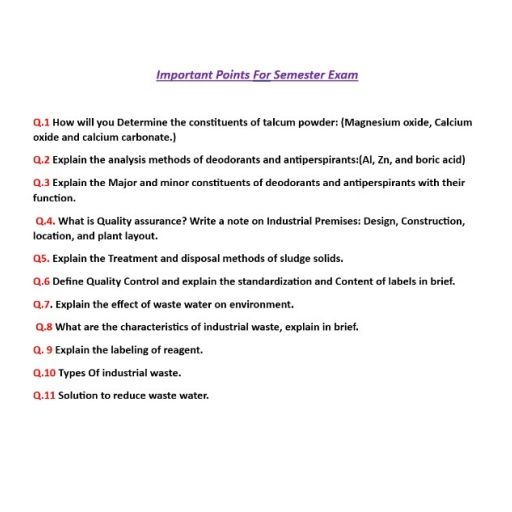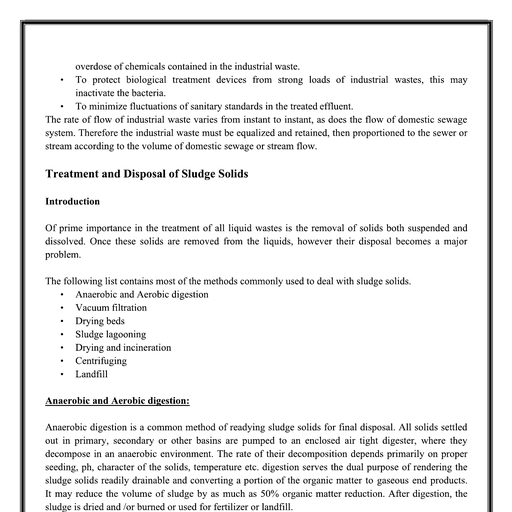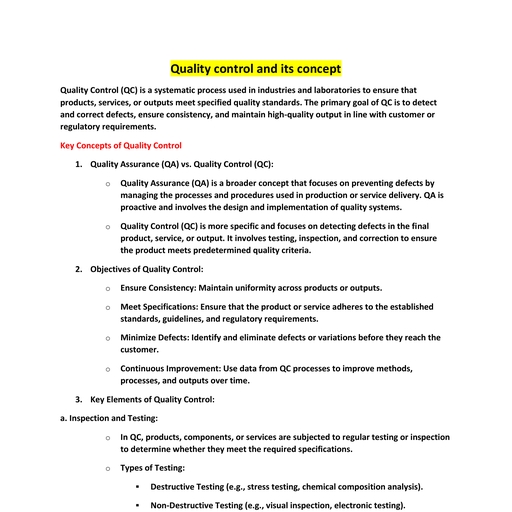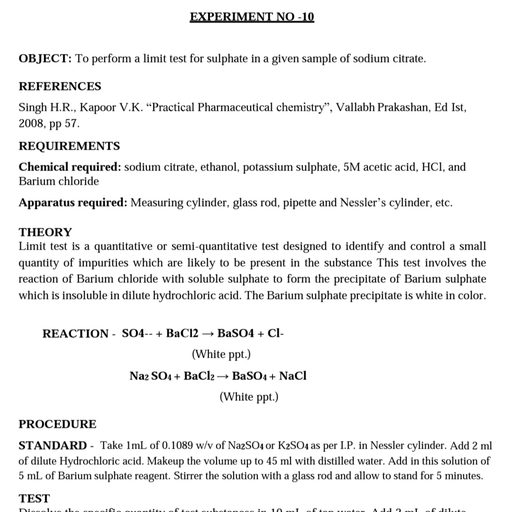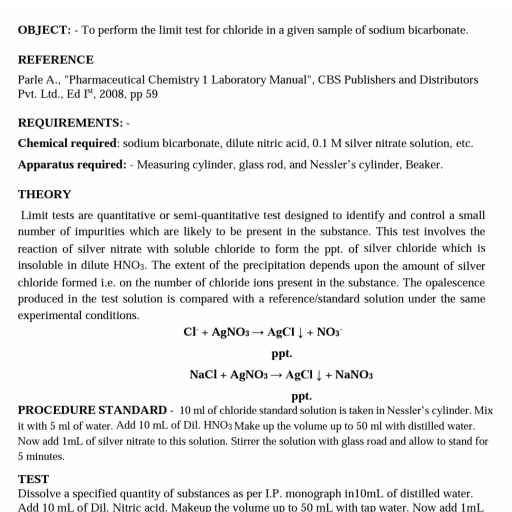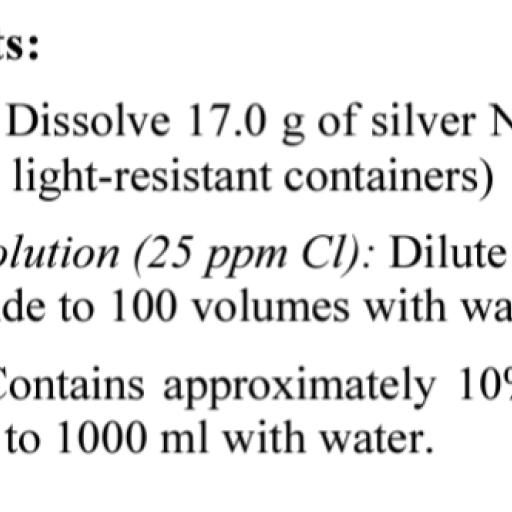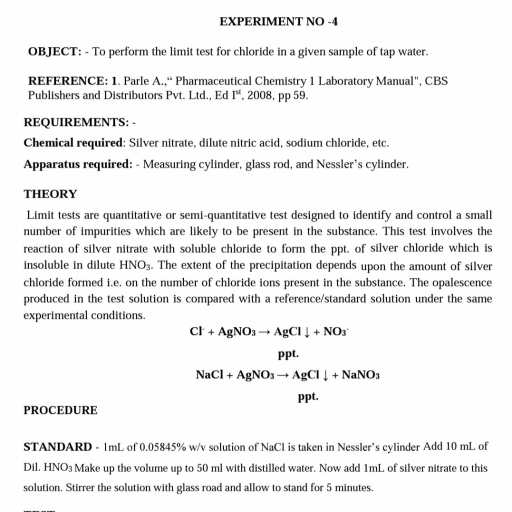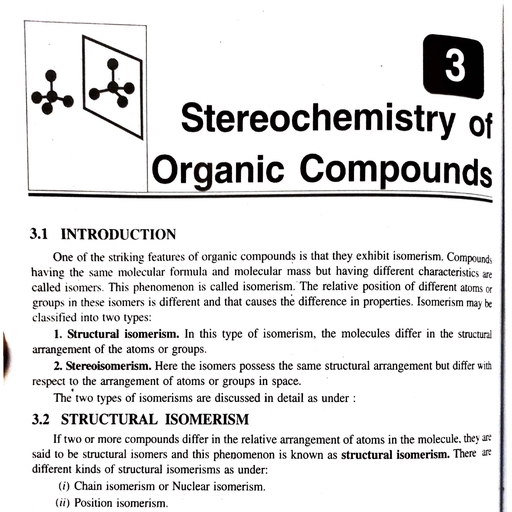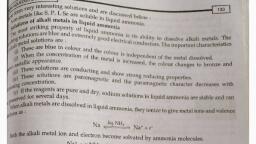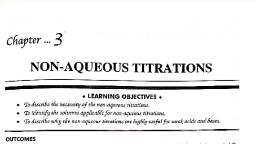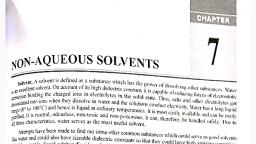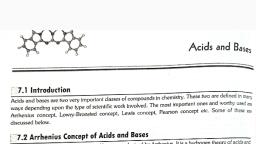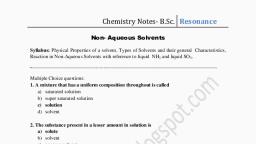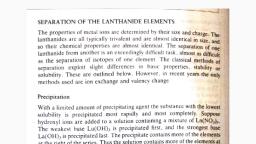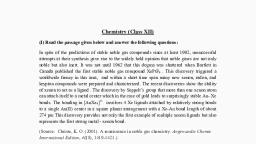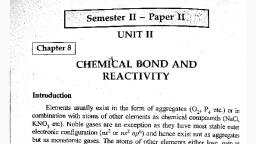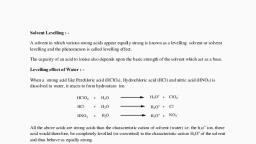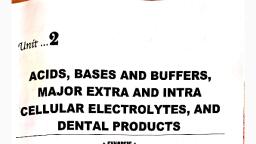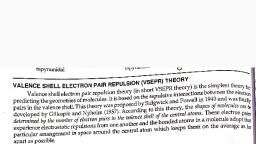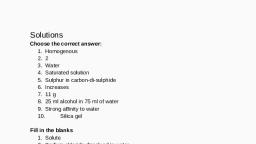Page 1 :
a: eae ®, Mixture Ww, Liquid, , Sulphur, , wove Non-Aqueous Solvents, BA. INTRODUCTION, , Since early times, chemical reactions have been carried out in water medium. This was becaug, , of easy availability of water in pure form. This is almost a free resource and then there are othe, , advantages like favourable physical properties, with a long range (0-100°C) for its liquid state anj, , high dielectric constant, which helps in the dissolution of other substances in it. Being neutral, non, toxic, odourless and non-poisonous, enhances its utility as a solvent. Lately, attempts have been mat, to find some other substances which could be used as suitable solvents for Inorganic substances, Wt, have met Success in the development of substances such as liquid ammonia, liquid sulphur dioxié,, liquid hydrofluoric acid and liquid nitrogen tetroxide. In the Present chapter, we shall discuss liqui, ammonia and liquid sulphur dioxide as solvents., , , , , , , , , , , , , , 82: PHYSICAL PROPERTIES OF SOLVENTS AND THEIR ROLE IN, CHEMICAL REACTIONS, , The utility of a solvent is determined from its, reactions and separate the products convenient!, solvents are discussed below:, , 8.2401 Melting point and boiling point (Liquid range), , ions i ; Fn dian Hui, Most of the reactions in a solvent system are carried out in liquid phase, therefore, the i, point and boiling point give the temperature range within which the solvent is useful. The ™, and boiling points for some common solvents are given in Table 8.1., , Properties that may help to carry out the chemi, y. Some of the important physical properties of, , Table 8.1 Melting points and boiling points of some common solvents., , , , , , Solvent . m.p. (°C) b.p. °C) |, , H,O 0.0 100, , NH, -71.7 -33.4, , HF -89.3 19.5, , so, =15:5 -10.2, , CH,COOH 16.6 118.1 j, , , , , , , , , , , , , , a, atic”, ble that water h ellent liquid range (0 to 100°C): ae, ‘ above table that water has exc: we, te at at ordinary temperatures while NH; and SO, work as solve, solv, can also act as, , temperatures. 300
Page 2 :
NAS, , , , , , , , , , , , , , , , y Heat of fusion and heat of vaporisation, WA, , The values of heat of fusion and heat of vaporisation help to know the nature and strength of, ve which hold the molecules of the solvent together in the solid or, ‘i uid state. Larger the value of heat of fusion or heat of vaporisation,, : a get are the intermolecular binding forces in the solid or the, 4 respectively. Thus the magnitudes of molar heat of fusion and, sar beat of Vaporisation give us an idea of the nature and strength of, , intermolecular forces. This helps to determine the suitability of a, tant casa solvent., , , , , 4 better idea of the intermolecular forces in a solvent is less, , , , ved by the ratio of molar heat of vaporisation to the boiling point,, hs ratio 1s Called Trouton constant, ie.,, AH Trouton, iar ya = Trouton constant Trouton, 5, , For normal liquids, if molar heats of vaporisations are expressed in calorie, solute scale (0 K), then the Trouton constant has the value of about 90 for n, ids exist as independent molecules without any bonds between them. A hig, ‘slant indicates association in molecules. Common solvents like water, ammonia. hydrogen, uonde have Trouton constant value greater than 90 and are, therefore, associated liquids. The, , cules of these liquids are polar. The association of polar molecules is due to their tendency to, ‘ni themselves so that the oppositely charged ends of the molecules come near to each other. Table, ~ eves the molar heats of fusion and vaporisation of some solvents., , s and boiling point, ormal liquids. Such, her value of Trouton, , , , Table 8.2. Molar heats of fusion and vaporisation of some solvents, , , , , , , , , , Solvent Molar heat of fusion Molar heat of vaporisation |, (kJ mol") (kJ mol!) |, Water 6.0 40.65, Ammonia 5.65 23.56, | Sulphur dioxide 7.40 24.94 |, Hydrogen fluoride 4.58 30.26 |, , , , , The above table shows that the values of molar heats of fusion for water and ammonia are, Mast, , same. This Means that the forces which hold molecules together in water and ammonta are, “magnitude Thus, these substances will serve as similar solvents, , Se Dielectric Constant, , Sordi Property helps to estimate the solubility of polar or non-polar substances in the solvent, OB to Coulombic law, the force of attraction between two charged ions is given by, , , , *q m, re 44, here i Dr°, emp is on are the charges of the cation and anion respectively, r is the distance between, , a, ., e c : vant. 1 Die large. thé facke B un, Sma}y Thue stant Called the dielectric constant of the solvent. If D is large, the force F will, , > Only a small amount of energy will be required to separate the tons and hence
Page 3 :
S— Ty, , nic substance. With the decrease in dielectric Constany, the, Il decrease. The dielectric constants of some common SOlven, , it will be easy to dissolve an io}, solubility of ionic compounds wi, are provided in Table 8.3., , Table 8.3 Dielectric constants of some comon solvents., Solvent, , , , , , , , , , , Dielectric constant (D), , 81.7 (at 18°C), 22.0 (at -33.5°C), 17.3 (at -16°C), , 9.7 (at 18°C), 83.6 (at 0°C), 123 (at 16°C), 100 (at 25°C), , bO are good Solvents for Pola, ir high dielectric constant values. On the other hand, solvents like Ni,, i 'w smaller tendency to dissolve ion:, , 82:4, Viscosity, , Viscosity gives a Measure of the fluidity of the solvent. Solvents like water, ethy! alcohol ai, carbon tetrachloride have low Viscoscities and flow rapidly under ordinary temperatures, In solves, of low viscosities, the Operations such as Precipitation, crystallization, filtration etc, can be easih, carried out without any difficulty. With increasing viscotiy of a liquid, the difficulty of such Operation, increases. Solvents like anhydrous Sulphuric acid have higher viscosities and this Feduces the, usefulness as solvent,, , 83,79 PEs OF SOLVENTS, , 7 Tonizing and Non-lonizing Solvents, , SM) Tonizing solvents, These are polar in nature and dissolve ionic Compounds. In these soles, ionic reactions occur. They also show Self-ionization, Ammonia, Sulphur dioxide and hydroflut, acid are examples of ionizing solvents,, , , , , , , , , , NH, + NH, ==, , NHj +NH3, SOS, eat ate + $03OH FY HES, , compounds. No ionic Teactions occur in these, and carbon tetrachloride are examples of non., , ‘ Protic and aprotic solvents, , Solvcats such as NH; or HF which, , have hydrogen as their Constituent are called pr”, Solvents such as SO, which have no hydrogen in the, , it molecule are aprotic solvents.
Page 4 :
,, ” 306 CHEMISTRY FOR DEGREE STUDENTS-1 (INORGANIC CHE Me,, hy, , , , , , , , , , , , , , , 8.5.5. Solvolytic reactions or solvolysis :, The reactions in which the solvent molecules react with the solute in such g way |, solvent molecules split up into two parts, one or both of which get attached to a, molecule or ion are called solvolytic reactions, These reactions occur through self iOnig, the solvent therefore the concentrations of either the cation or the anion ig changed Sot, reactions in water, ammonia and ethanol are given below: a, , (i) Water as solvent:, , hy,, , 2H,0 == H,0*+OH (auto ionization), , SO,Cl, + 4H,0 == SO,(OH), + 2H,0° + 2CI, (Cone, of H,0* is increased), , F H,O == HF+OH (Conc, of OH is increased), (ii) Alcohol as solvent:, , 2C,Hs;0OH == C,H,OH,* + OCH, (auto ionization), , SO,Cl, + 4C,H;0H == S0,(OC>Hs), + 2C,H,OH,+ 2C1, (Conc. of C,HsOH,’ is increased), “CH; + C,H30H —— OC,H; +CHy (Cone. of OCH, in increased), (iii) Ammonia as solvent:, 2NH, *—— NH,’+NH, (auto ionization), , SO,Cl, + 4NH; === SO,(NH)), + 2NH,’ +2CI” (Cone. of NH’ s ome, , H'+NH,; == NH, +H, (Cone. of NH,” in increased), Comparison of physical properties of ammonia and water, Some physical properties of water and ammonia as solvent are given in Table 8.4, , Table 8.4 Physical Properties of ammonia and water., , , , , , , , , , , , Property Ammonia Water, 1, Freezing point or melting point (K)| 195.3 273, 2. Boiling point (K) 239.6 373, 3. Dielectric constant 22 at 239.6 K 81 at 291K, 4. Ionic product 1.9% 10-3 at 223K | 1x 10°! at 298K, 5. Specific conductance 9.0 10°! at 195 K | 6 x 10-6 at 298K |, 6. Dipole moment 1,148 at 233 K 1.84 at 291 K, 7, Latent heat of fusion J/kg 0.34 0,33, , , , , , / LIQUID NH, AS A SOLVENT, Important characteristics of ammonia as a solvent,, , . i liquid ammonia are: quid, important points about liq’ i liqu!, Some is ammonia molecules are associated through hydrogen —s ya, (i) me a strongly electronegative element-nitrogen, which is responsible, as it contains, , init.
Page 5 :
US SOLVENTS, , , , , , , , , , , , , , , , , , , , , , , , , , yaad 307, ii) The lower value of its dielectric constan|, monia is a POOF electrolytic solvent than water,, (iii) Lower viscosity of liquid ammonia tends to, egcome, 10 some extent, the dielectric constant effe, er when dissolved in liquid ammonia than when di, ‘rof liquid ammonia but due to low viscosity w/, , tas compared to that of water shows that liquid, , Promote greater ionic mobilities and thereby, ct. Most salts actually conduct electric current, solved in water. This is not due to high ionizing, u hich increases the mobility of ions., , (iv) The melting point and boiling point of ammonia are abnormal with respect to PH;, AsH; and, py, due £0 intermolecular association occurring in it as a result of H-bonding. The peaiig and, ling points of liquid ammonia are lower than those of water. Therefore, en while handling liquid ammonia. ‘, , () Among the soluble compounds in liquid ammonia are nitrates, nitrites, thiocyanates and most, anides. The majority of fluorides are insoluble, as are oxides, hydroxides, sulphates, carbonates,, sphates, sulphites and most sulphides. Among the halides, other than the fluorides, solubility, eases from the iodides to the chlorides. Most iodides (even that of: silver) are soluble, the bromides, less soluble and among the chlorides only the ammonium, beryllium and sodium compounds are, , , , more precautions are to be, , (vi) Because of its ability to donate lone pair of electrons to form a covalent coordinate link as, | as by ion-dipole attractions, ammonia forms many solvates which are analogues of salt-hydrates., (vii) In general, solubilities of covalent organic compounds in liquid ammonia are considerably, gher than in water probably due to greater dispersion energy interactions., , (viii) The specific heat of ammonia is higher than that of water., , (ix) Liquid ammonia possesses unusual high thermal coefficient of expansion, i.e., its density, Teases With rise in temperature., , (x) It has high critical temperature and pressure., , (xi) Liquid ammonia is a very poor conductor of electricity., , (xii) Liquid ammonia is an ionizing solvent, i.e., undergoes ionization though to a lesser extent as, mpared to water., , 6.1 Auto-ionization of liquid ammonia, The ionization of ammonia is supposed to take place just like that, , :, ;, ;, ;, :, , of water,, , 2NH, === NH, + NH;, , Ammonium = Amide, ion ion, + + OH”, 2H,0 == H30 Hydroxide, , Hydronum ion, , ion :, : But the ionization of ammonia is very small as is evident from its low conductance and also from, Se product, ie,, = [H,O* ] x [OH] = 1* 10-4 at 291K, = LBs, , = [wut [NH ] = 1,9 x 10°33 at 223K, , Kino, , Kyu,








